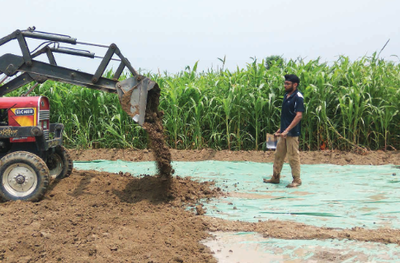Paddy in Punjab - Sustainable Water use
Paddy in Punjab - Sustainable Water use
The challenge
Punjab produces a lot of Paddy, and it also requires a lot of water. The Green Revolution during the 70s indeed improved the productivity and the yields of the fields in Punjab, but its outcome also resulted in contaminating groundwater with chemicals and pesticides.
Punjab is predominantly an agricultural State with the highest percentage of irrigated land. Paddy is widely cultivated in the State and requires a large amount of water for irrigation. In Punjab, paddy is cultivated in 2.814 million hectares, and 73% area is irrigated by tube wells. The continuous withdrawal of ground water for paddy cultivation has resulted in a rapid decline of the water table in Punjab. About 50-80% irrigated water is percolated in soil with chemicals which are used in fields for paddy production. It causes both ground water pollution and soil pollution.
The solution
Objectives
- To reduce water percolation by 50% that can help to save groundwater and soil pollution
- To help save 50% power consumption used for pumping out water for irrigation of paddy crop.
- To increase the yield of paddy crop
- To reduce the use of chemical fertilisers by about 50%
Implementation
The experimental trials were first conducted in plots in Lyallpur Khalsa College campus and later in small plots of 100 square feet area in village Ladhewali, Jalandhar in 2015. Then in 2016, a study was conducted in the Kharif season at village Khadoor Sahib in Tarn Taran District of Punjab.

First, the top layer of soil of the thickness of about 18 inches was removed. Then a degradable layer of plastic sheet (HDPE) was laid at the bottom to prevent percolation of water into deeper layers of the soil. Then the removed soil was spread on the plastic sheet, forming a layer of 18 to 24 inches. This was done to prevent the excess absorption of water and fertilisers by deeper layers of soil during irrigation. As Paddy has adventitious roots, less than 2% of the total rice root length grows below 16 inches soil depth. Nearly 90% of total root length produced by the corresponding nitrogen, phosphorus and potassium uptake occurred within the upper 8 inches of the soil profile. So, Paddy can easily be cultivated and grown with this method with minimum use of water resources.
Outcome
After monitoring and harvesting the crop, the results were compared with the traditional method. Water consumption declined by 50-60% while the yield increased by 10-15%. This method also helped to prevent percolation of excessive fertilisers and pesticides into deeper layers of soil and underground water. It also proved cost effective, as 50% of electricity or diesel expenditure was saved by farmers because only 50% water is required for irrigation.
This initiative by Lyallpur Khalsa College supported by Ministry of Agriculture can help in a long way to arrest the decline in the water table, check underground water and soil pollution. It is cost - effective and environment-friendly. It now remains to be seen how soon can this system be replicated in other paddy growing States.
ફેરફાર કરાયાની છેલ્લી તારીખ : 6/23/2024
Bhasha Sangam initiative for schools and educatio...
This topic covers information about model bankable...
This topic provides information about Additional S...
This topic provides information about Blue Revolut...
